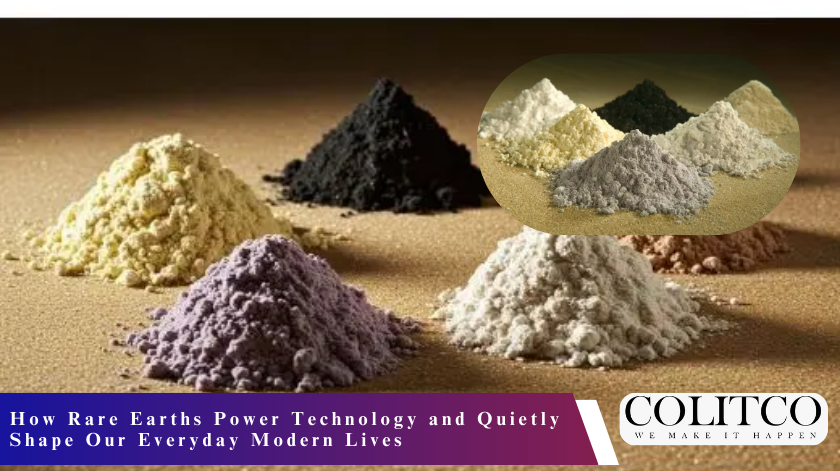Rare earth elements may seem distant from daily routines, yet they shape modern living. They are in the form of minerals that power smartphones, electric cars, solar and wind energy, and military technologies.
To learn the role of rare earths in technology is to learn how society is influenced by them. From households to hospitals, their importance is still growing. And as the world demand increases, the countries that are already in the race to get assured supplies for a long time will be the winners. Indeed, sometimes the materials do not occur in nature very rarely, but still, their extraction is not easy and cost-effective.
The processing involved is quite complicated and hence makes the materials expensive and geopolitically sensitive. Rare earth elements are actually operating behind the scenes of screens, lights, and motion, silently in everyday life. They are not directly perceived by consumers, but the technology sector continues to rely on them significantly.

Rare earth minerals quietly power smartphones, clean energy, electric cars, and defence.
What Are Rare Earth Elements In Daily Technology?
Rare earth elements are a combination of the 17 metals that have been placed in the periodic table. They are the likes of neodymium, dysprosium, lanthanum, and terbium. Apart from these, other elements are used in making strong magnets, specialised glass, and long-lasting batteries.
They have the modern electronics ecosystem integrated in such a way that it would be difficult to point out any electronic device that does not use them. For instance, a smartphone has more than 30 different minerals and metals in it. Rare earth elements in daily life can be realised through sound, vibration, screen colour, and touch sensitivity. For example, headphones make use of neodymium magnets to provide a clear sound. Also, the sensors in cameras that use rare earth materials give very accurate images.
The uses of rare earth minerals are quite extensive; for instance, they have infiltrated home appliances as well. High-efficiency motors that are very durable and consume less energy, thanks to rare earth magnets, are used in washing machines, refrigerators, air conditioners, etc.
How Does Rare Earth Power Technology Work in Homes?
The moment you click the switch to light up your space, rare earth elements already perform their functions. Among the materials that make up LED lighting, yttrium and europium feature prominently. The lights, depending on these elements, are nothing short of bright and energetic.
Next to rare earths in the living room, the TVs are most likely using them for good colour reproduction and energy efficiency. The displays of the TV rely on phosphors that come from these minerals. Rare earths play a significant role in laptops concerning battery performance and heat resistance.
Electric razors, fans, and vacuum cleaners come with small motors that use rare-earth magnets for torque and durability. Smart home systems use rare earths in the components (sensors, connectivity, and automation). This indicates that the use of rare earth minerals in the home is so ingrained that it becomes invisible. Modern comfort systems would lose their efficiency and performance without them.

Switching lights activates rare earths; yttrium and europium brighten efficiently.
Why Are Rare Earths So Critical Globally?
The worldwide consumption of rare earths is on the rise at a fast pace as a result of the transition towards the use of clean energy. The spinning of wind turbines is done through the use of rare earth magnets, which also help generate electricity from them. A significant part of the electric car’s weight goes to the motors and battery systems, which need rare earths.
An electric car has about six times the mineral content of a petrol car. Lithium, cobalt, copper, and rare earths are included in this. With the government’s announcement of a net-zero initiative, the demand continues to increase. The production of rare earth minerals is still concentrated in certain countries, and only a few can handle the processing of such minerals.
Therefore, the global tech industry is at risk of being cut off from the supply chain. The reliance on rare earths in technology is not only about convenience but also about the strategic significance. They are the factors that influence the digital industry, green energy, and defence sector developments all over the world.
How Rare Earths Power Technology In Defence Systems?
Modern military capabilities cannot do without rare earths. Their magnets are necessary for the navigation and control systems of jet fighters. Rare earths are also used in the missile guidance systems of precision-guided missiles for high targeting accuracy. The detection sensitivity of advanced radar and sonar systems is related to the use of rare earths.
Silent and efficient operation of submarines and drones is now associated with rare-earth motors. Moreover, rare earth materials are mined for secure signal transmission in communication systems. These minerals are so important that national security policies already consider it a priority to secure their supply.
Governments are putting a lot of money into domestic critical mineral projects. This is a way to guarantee strong sources for defence manufacturing. The use of rare earth minerals in defence is just one indication of their strategic value beyond the civilian market. They are part of the national security frameworks in many countries and thus form a global pattern.

Rare earth magnets enable jet navigation, missile guidance, and radar systems.
Who Controls The Rare Earth Supply Chain?
At the moment, rare earth global production and processing are very concentrated. The refining capacity of one country dominates the global market. Such a concentration leads to security and trade concerns. Other countries are now looking for ways to mitigate the risk by moving forward with their mining projects and forming partnerships.
There are plans for constructing alternative processing hubs in Australia, the United States, and Europe. Yet, it will take many years and a lot of money to set up new facilities. Until the diversified supply chains are completely established, the world will continue to rely on one source. This will have an impact on the prices, availability, and long-term technology planning.
The rare earth elements are therefore closely linked to global geopolitics in everyday life. The race for supply security shows that rare earths are indeed the drivers of technology in all sectors.
What Does This Mean For The Future Of Daily Life?
Future technologies will rely even more on rare earth elements than today. Artificial intelligence, electric and self-driving cars, and solar-wind power systems all need lots of rare earths.
Additionally, medical imaging machines are also manufacturers of rare earth products. Rare earths may not be visible to the end consumer. Nevertheless, changes in prices or supply shortages can affect the availability and cost of technology. Thus, the security of rare earth has become an issue of economic stability.
The knowledge about where rare earth minerals are used helps the public see their hidden value. They are not only minerals but also the very basics of modern civilisation. The way rare earths power technology will be a major factor in the technological progress of the coming decades.
Frequently Asked Questions
Q1: What benefits do rare earth elements bring to everyday life?
They provide power to the entire range of electronic devices from smartphones to modern digital infrastructure, via EVs and renewable energy systems.
Q2: Is it easy to replace rare earth elements?
Most of them possess such unique magnetic and chemical properties that an efficient substitution is difficult to achieve.
Q3: What makes rare earth supply a risk?
Because the refining process is heavily concentrated in a few countries, any disruption in supply can severely impact the tech industry.
Q4: What is the role of rare earth in the renewable energy sector?
They are the main components behind the high efficiency of wind turbines, electric motors, and energy storage technologies.












